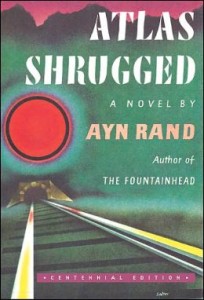 Ayn Rand’s Atlas Shrugged is a literary masterpiece and one of the most read and discussed novels of the 20th century. It tells the story of “men of the mind,” led by John Galt, who go on strike as the world around them collapses in a rubble of irrational philosophy, rights-violating government policies, and the economic disasters that follow.
Ayn Rand’s Atlas Shrugged is a literary masterpiece and one of the most read and discussed novels of the 20th century. It tells the story of “men of the mind,” led by John Galt, who go on strike as the world around them collapses in a rubble of irrational philosophy, rights-violating government policies, and the economic disasters that follow.
The trilogy of films—the final installment of which was released in theaters yesterday—is a cheap, inept attempt to represent the original. A scene from Rand’s novel provides an apt comparison: Dagny Taggart hears a bastardized version of a Richard Halley musical composition on the radio, but she can still detect traces of the original’s greatness. So it is with the films relative to the novel.
I could spend pages describing the flaws of Atlas Shrugged III: Who Is John Galt?, but there’s no point in doing so. Instead, I’ll mention only a few of the more obvious problems.
Apparently for PR purposes, the film includes gratuitous cameos of conservative icons Glenn Beck and Sean Hannity, and libertarian Ron Paul, each appearing as himself. (Rand legitimately would have been outraged at the spectacle of such figures posing as spokesmen for her ideas.) Awkward narrative voiceover establishes the backstory and pronounces various plot developments; for example, a voice announces the main Taggart railroad bridge has collapsed due to regulation, without explaining what regulations led to the collapse. The characters of Francisco d’Anconia and Ragnar Danneskjöld are badly miscast; among other problems, the actor portraying Francisco is far too old for the part, and the actor portraying Ragnar fails to convey the charm, sophistication, and intelligence of the pirate. Even many of the details are distracting; for example, to create the mountain hideaway, Galt’s Gulch, the film awkwardly meshes scenes of high Colorado mountains with giant redwood forests of California.
That said, the film—despite its paltry $5 million budget—has a few positive qualities worth noting. For the most part, when the film seeks to convey the ideas of the novel, it gets them right. A number of the scenes are competently done—my favorite is when Dagny (portrayed by Laura Regan) responds to a failure of automated train signals by instructing her railroad employees to devise a system of hand signals. Much of the acting is competent: To a substantial degree, Kristoffer Polaha convincingly portrays Galt (despite the western kitsch of Galt’s clothing and house); and most of the actors portraying Galt’s friends in the Gulch as well as the villains do a fine job. The writers made a good choice in focusing the film primarily on the romantic relationship between Galt and Dagny and conveying the highly complex story mostly from that central thread. On the whole, I’d give the film a C-minus.
Whatever one’s assessment of this effort, the film and the trilogy have brought wider attention to Rand’s magnificent novel, and that is a good thing. Would a better film have better served this purpose? Of course. And hopefully someone will produce a better film version of Atlas in the future.
Although this film asks, “Who Is John Galt?” and only hints at the answer, Rand’s masterpiece stands waiting to provide the complete answer, in a profound and wonderful story. Just as Atlas Shrugged cannot be sullied by vicious attempts to smear it, nor by confused or shallow attempts to defend it, so too the novel cannot be sullied by shoddy attempts to imitate it. John Galt stands on his own.
Related:
- Atlas Shrugged and Ayn Rand’s Morality of Egoism
- Transfiguring the Novel: The Literary Revolution in Atlas Shrugged


![[TEST] The Objective Standard](https://test.theobjectivestandard.com/wp-content/uploads/2017/10/logo.png)














